The Samsung Galaxy S6 and S6 edge Review
by Joshua Ho on April 17, 2015 9:00 AM EST- Posted in
- Smartphones
- Samsung
- Mobile
- Galaxy S6
- Galaxy S6 Edge
NAND Performance: The First UFS Phone
Storage performance is often a critical area for user performance, as applications cannot be cached in RAM at every possible moment. Camera performance is also often limited by storage performance as RAM buffers can only do so much to maintain performance before it’s necessary to commit photos to non-volatile storage.
However due to the memory hierarchy to some extent, storage performance is often hard to notice once it’s at a point where things are “good enough”. Unfortunately, in some cases we can see OEMs failing to include sufficiently performant solid-state storage, which can be a major pain point in the user experience when random read/write performance is low enough that there are noticeable IO pauses as the system has to wait for data to be loaded from storage.
The Samsung Galaxy S6 family is the first shipping implementation of UFS (Universal Flash Storage) 2.0 standard, which makes the internal storage model less like an SD card in nature. When comparing the eMMC 5.1 standard to the UFS 2.0 standard, we see a move from a the 400 MB/s maximum of the eMMC 5.1 standard with HS400 physical link interface to MIPI M-PHY, which allows for a theoretical maximum of around 720 MB/s and should be more efficient in transmitting data than the current eMMC standard. In addition, UFS makes it possible to do full duplex communication, which means that reads and writes can happen simultaneously. There's also a command queue, which helps to avoid inefficiencies that could arise from waiting for commands once a command has been processed by the storage controller, and utilizes the SCSI protocol to facilitate these new features at the interface level.
As for the Galaxy S6 itself, the UFS implementation Samsung is using is Samsung developed. Samsung's current implementation only supports up to 300 MB/s (or 2.4 Gbps) transfer rates as a theoretical maximum, so from an interface perspective it's still not reaching the full capabilities of the standard. Though even at a cap of 300MB/sec, it still stands to be a significant improvement over typical eMMC solutions.
Finally, on a technical note, the 32GB models are of the model KLUBG4G1BD-E0B1 with a maximum queue depth of 16.
In order to test storage performance, we use Androbench with some custom settings to get a reasonable idea of performance in this area, although this test isn’t an exhaustive examination of storage performance by any means.
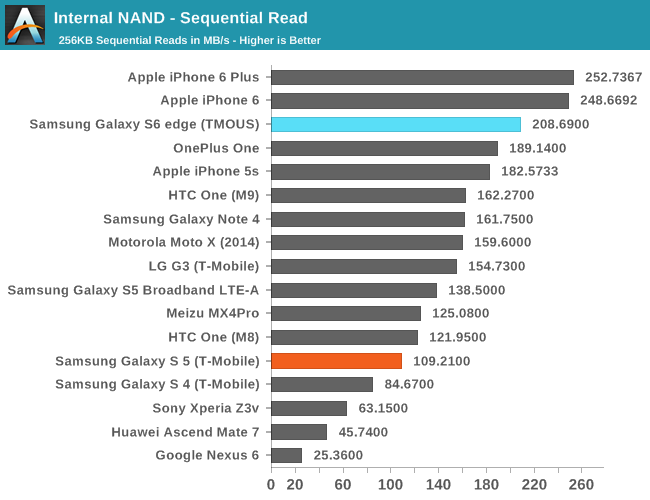
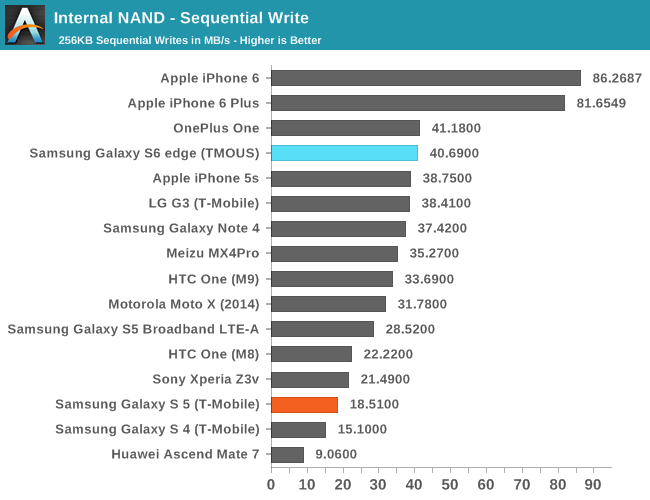
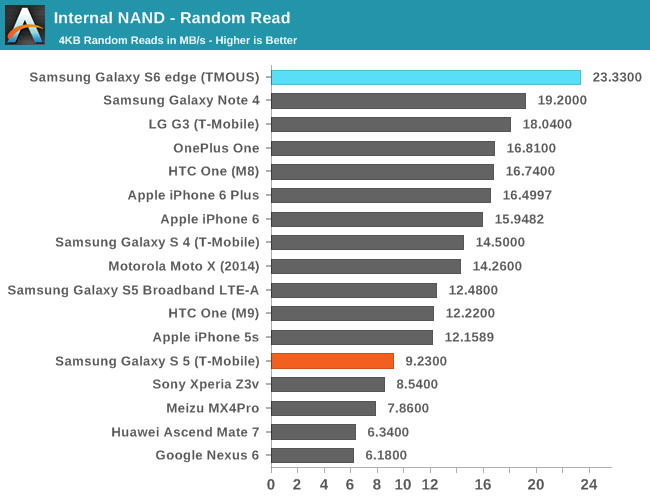
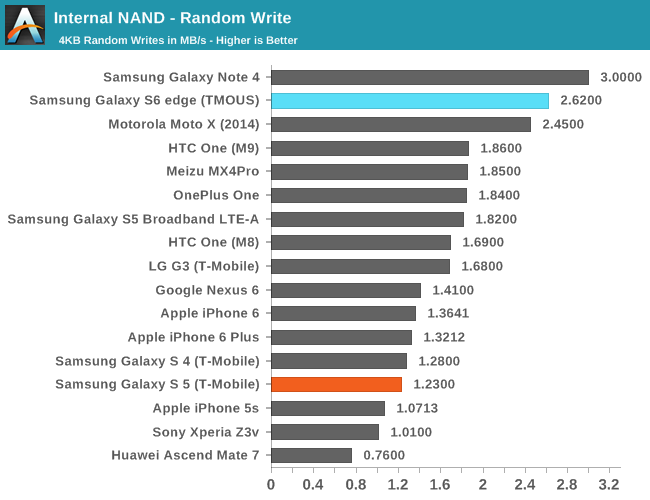
The Galaxy S6 performs rather impressively in our standard storage test, but not as fast as one might have hoped. This is due to the nature of the Androbench 3.6 test, which only tests a single IO thread, which won’t use the UFS storage of the Galaxy S6 to its full extent. In order to see the kind of difference that UFS really makes, I ran the same test again on Androbench 4.x, which does support multiple IO threads. However, as our iOS storage test and Androbench 3.6 don’t support more than a single IO thread we will continue to present both results for now.
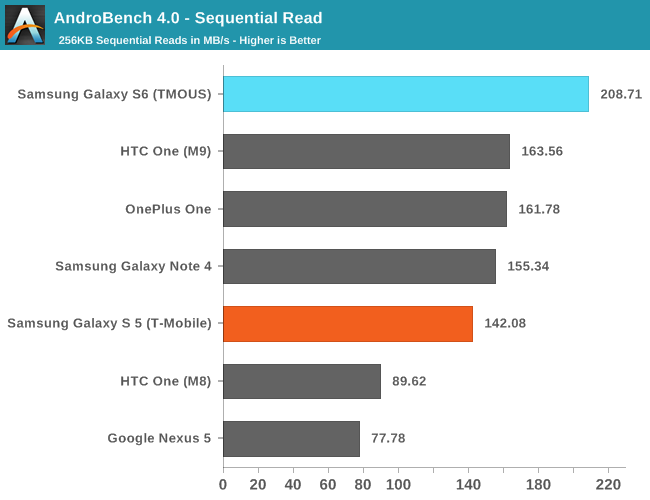
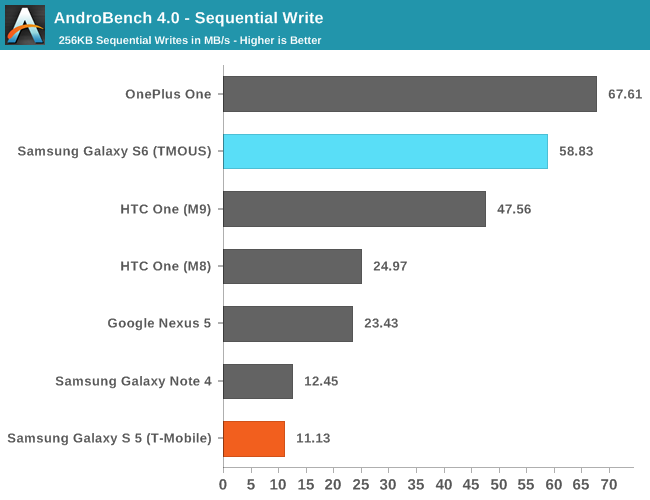
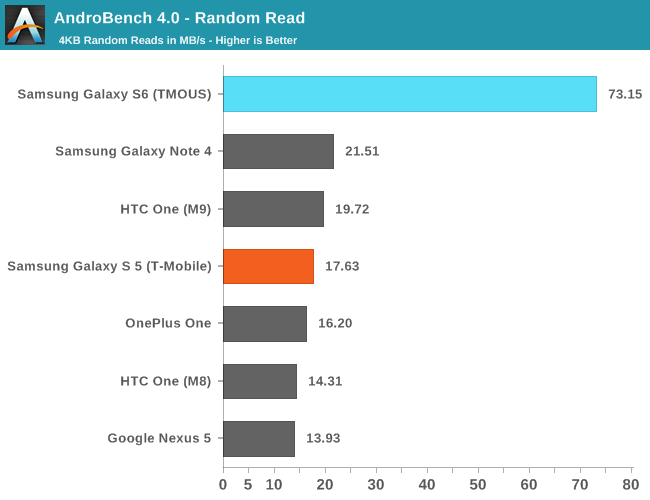
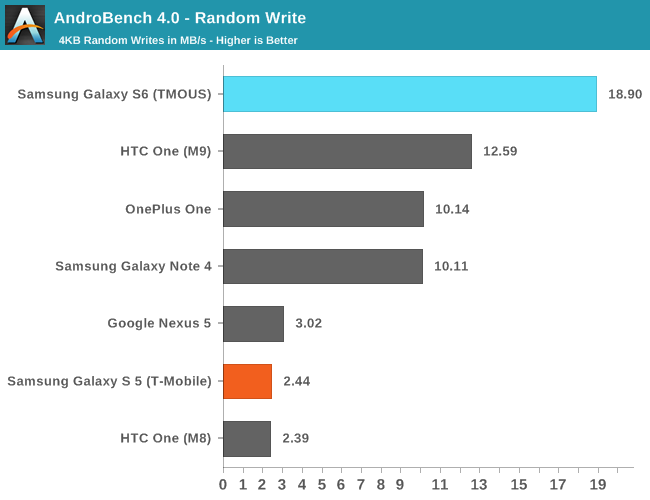
Overall, there are some immense benefits in storage performance here, especially in random IO performance. The Galaxy S6 has some of the fastest storage available in a phone today as far as I can tell given that this is basically a pure MLC solution, and shouldn’t have any real issue with storage performance holding back the rest of the phone over the course of 1-3 years as long as a reasonable amount of free space is kept to allow efficient storage management.


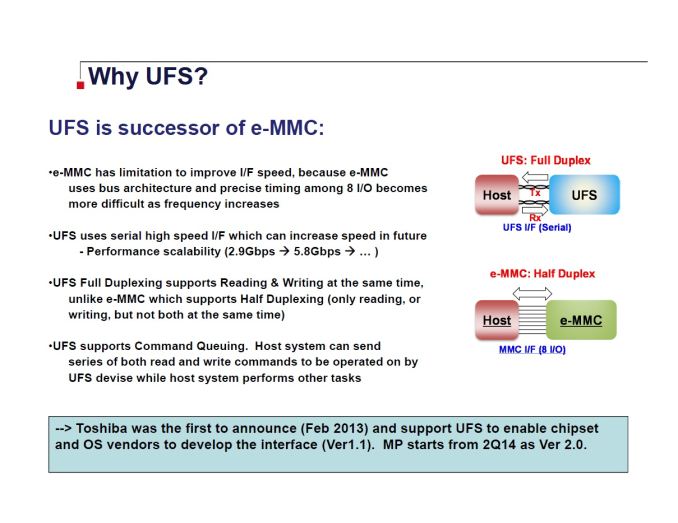








306 Comments
View All Comments
JeffFlanagan - Friday, April 17, 2015 - link
I agree that the lack of a removable battery will be a problem for some people, but I don't know how big a segment of the market that is. We'll find out how well Samsung understands their market over the next couple of months when we see how well the S6 sells.FlushedBubblyJock - Friday, April 24, 2015 - link
and one of the 1st reports is the selling aka pre orders have been inflated and only 2/3rds have panned out - so the sales are droopy...http://www.androidauthority.com/samsung-galaxy-s6-...
So they are crap. Oh well, appleheads will be very pleased.
Anand321 - Saturday, April 18, 2015 - link
SOlution is simple!!Carry a power bank and whenever battery is down, charge it in 1/2 hour.
They also have wireless charging option, which you can use. There are wireless charging power bank also in the market.
So instead of buying a 2nd battery and always carrying it, carry a power bank. Thats enough.
But one thing...this phone lasts more than 7-8 hours even after continuous heavy usage!!
FlushedBubblyJock - Friday, April 24, 2015 - link
I love the feel of toting around that extra large battery powerbank and having the wireless charger doohickie plugged in as an add on wherever I need it, it just adds to the feel when I stroke my metal industrial design and take some personal touch moments with it in my hand.Anand321 - Saturday, April 18, 2015 - link
Also taking care of the fact, that a phone is hardly used after 2/3 years, that extra battery will be of now use after you change your phone. But with wireless charging and such wireless power banks, you dont have to spend money on battery every 2 year!!Makes sense..ain't it!!
opx4real - Friday, April 17, 2015 - link
So...you clearly didn't make it all the way to the memory page before you just HAD to voice your knee jerk reaction.darkich - Saturday, April 18, 2015 - link
While the ask if SD support is technically a functional downgrade, people tend to forget that Samsung is in turn offering the most advanced internal storage that offers unprecedented speed and uncompromising performance.And I'd say that's a fair trade.
darkich - Saturday, April 18, 2015 - link
*while the lack of SD support *FlushedBubblyJock - Friday, April 24, 2015 - link
while others tend to forget an sd card slot could be included too, thus there would be no trade off, just a massive improvementjuxt417 - Wednesday, April 22, 2015 - link
It has nothing to do with being more iPhone like. An SD card would lag horribly when loading and taking those beautiful 4k pictures it is capable of producing. Not to mention it would cause lag throughout the u.i. and cause unnecessary power drain.